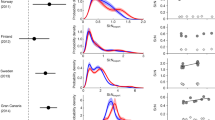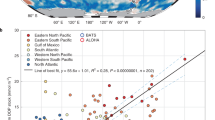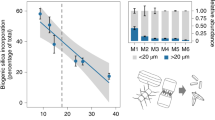Abstract
Zinc is vital for the physiology of oceanic phytoplankton. The striking similarity of the depth profiles of zinc to those of silicate suggests that the uptake of both elements into the opaline frustules of diatoms, and their regeneration from these frustules, should be coupled. However, the zinc content of diatom opal is negligible, and zinc is taken up into and regenerated from the organic parts of diatom cells. Thus, since opaline frustules dissolve deep in the water column while organic material is regenerated in the shallow subsurface ocean, there is little reason to expect the observed close similarity between zinc and silicate, and the dissimilarity between zinc and phosphate. Here we combine observations with simulations using a three-dimensional model of ocean circulation and biogeochemistry to show that the coupled distribution of zinc and silicate, as well as the decoupling of zinc and phosphate, can arise in the absence of mechanistic links between the uptake of zinc and silicate, and despite contrasting regeneration length scales. Our simulations indicate that the oceanic zinc distribution is, in fact, a natural result of the interaction between ocean biogeochemistry and the physical circulation through the Southern Ocean hub. Our analysis demonstrates the importance of uptake stoichiometry in controlling ocean biogeochemistry, and the utility of global-scale elemental covariation in the ocean in understanding these controls.
This is a preview of subscription content, access via your institution
Access options
Access Nature and 54 other Nature Portfolio journals
Get Nature+, our best-value online-access subscription
$29.99 / 30 days
cancel any time
Subscribe to this journal
Receive 12 print issues and online access
$259.00 per year
only $21.58 per issue
Buy this article
- Purchase on Springer Link
- Instant access to full article PDF
Prices may be subject to local taxes which are calculated during checkout




Similar content being viewed by others
References
Morel, F. M. M., Milligan, A. J. & Saito, M. A. Marine bioinorganic chemistry: the role of trace metals in the oceanic cycles of major nutrients. Treatise Geochem. 8, 123–150 (2014).
Twining, B. S. et al. Quantifying trace elements in individual aquatic protest cells with a synchrotron X-ray fluorescence microprobe. Anal. Chem. 75, 3806–3816 (2003).
Twining, B. S. & Baines, S. B. The trace metal composition of marine phytoplankton. Annu. Rev. Mar. Sci. 5, 191–215 (2013).
Boyd, P. W. & Ellwood, M. C. The biogeochemical cycle of iron in the ocean. Nat. Geosci. 3, 675–682 (2010).
Moore, C. M. et al. Processes and patterns of oceanic nutrient limitation. Nat. Geosci. 6, 701–710 (2013).
Bruland, K. W. Oceanographic distributions of cadmium, zinc, nickel, and copper in the North Pacific. Earth Planet. Sci. Lett. 47, 176–198 (1980).
Martin, J. H., Gordon, R. M., Fitzwater, S. & Broenkow, W. W. VERTEX: phytoplankton/iron studies in the Gulf of Alaska. Deep-Sea Res. 36, 649–680 (1989).
Wyatt, N. J. et al. Biogeochemical cycling of dissolved zinc along the GEOTRACES South Atlantic transect GA10 at 40 °C. Glob. Biogeochem. Cycles 28, 44–56 (2014).
Berelson, W. M. The flux of particulate organic carbon into the ocean interior: a comparison of four US JGOFS regional studies. Oceanography 14, 59–67 (2001).
Ragueneau, O., Dittert, N., Pondaven, P., Treguer, P. & Corrin, L. Si/C decoupling in the world ocean: is the Southern Ocean different? Deep-Sea Res. 49, 3127–3154 (2002).
Sarmiento, J. L., Gruber, N., Brzezhinski, M. A. & Dunne, J. P. High latitude controls of thermocline nutrients and low latitude biological productivity. Nature 427, 56–60 (2004).
Sarmiento, J. L. et al. Deep ocean biogeochemistry of silicic acid and nitrate. Glob. Biogeochem. Cycles 21, B1S90 (2007).
Sunda, W. G. & Huntsman, S. A. Effect of Zn, Mn, and Fe on Cd accumulation in phytoplankton: implications for oceanic Cd cycling. Limnol. Oceanogr. 45, 1501–1516 (2000).
Ellwood, M. C. & Hunter, K. A. The incorporation of zinc and iron in the frustule of the marine diatom Thalassiosira pseudonana. Limnol. Oceanogr. 45, 1517–1524 (2000).
Lee, B.-G. & Fisher, N. S. Release rates of trace elements and protein from decomposing planktonic debris. I. Phytoplankton debris. J. Mar. Res. 51, 391–421 (1993).
Twining, B. S. et al. Differential remineralization of major and trace elements in sinking diatoms. Limnol. Oceanogr. 59, 689–704 (2014).
Armbrust, E. V. The life of diatoms in the world’s oceans. Nature 459, 185–192 (2009).
Assmy, P. et al. Thick-shelled grazer-protected diatoms decouple ocean carbon and silicon cycle in the iron-limited Antarctic circumpolar current. Proc. Natl Acad. Sci. USA 51, 20633–20638 (2013).
Sallée, J. B., Wienders, N., Speer, K. & Morrow, R. Formation of subantarctic mode water in the southeastern Indian Ocean. Ocean Dyn. 56, 525–554 (2006).
Marshall, J. & Speer, K. Closure of the meridional overturning circulation in the Southern Ocean. Nat. Geosci. 5, 171–180 (2012).
Zhao, Y., Vance, D., Abouchami, W. & de Baar, H. J. W. Biogeochemical cycling of zinc and its isotopes in the Southern Ocean. Geochim. Cosmochim. Acta 125, 653–672 (2014).
Khatiwala, S., Visbeck, M. & Cane, M. A. Accelerated simulation of passive tracers in ocean circulation models. Ocean Modelling 9, 51–69 (2005).
Sunda, W. G. & Huntsman, S. A. Feedback interactions between zinc and phytoplankton in seawater. Limnol. Oceanogr. 37, 25–40 (1992).
Baars, O. & Croot, P. L. The speciation of dissolved zinc in the Atlantic sector of the Southern Ocean. Deep-Sea Res. 58, 2720–2732 (2011).
Lohan, M. C., Statham, P. J. & Crawford, D. W. Total dissolved zinc in the upper water column of the subarctic North East Pacific. Deep-Sea Res. II 49, 5793–5808 (2002).
John, S. G. & Conway, T. M. A role for scavenging in the marine biogeochemical cycling of zinc and zinc isotopes. Earth Planet. Sci. Lett. 394, 159–167 (2014).
Elderfield, H. & Rickaby, R. E. M. Oceanic Cd/O ratio and nutrient utilization in the Southern Ocean. Nature 405, 305–210 (2000).
Cullen, J. T. On the nonlinear relationship between dissolved cadmium and phosphate in the modern global ocean: could chronic iron limitation of phytoplankton growth cause the kink? Limnol. Oceanogr. 51, 1369–1380 (2006).
Quay, P., Cullen, J. T., Landing, W. M. & Morton, P. Processes controlling the distributions of Cd and PO4 in the ocean. Glob. Biogeochem. Cycles 29, 830–841 (2015).
You, Y. Intermediate water circulation and ventilation of the Indian Ocean derived from water-mass contributions. J. Mar. Res. 56, 1029–1067 (1998).
Vu, H. T. D. & Sohrin, Y. Diverse stoichiometry of dissolved trace metals in the Indian Ocean. Sci. Rep. 3, 1745 (2013).
Geotraces Intermediate Data Product 2014 v.3 (GEOTRACES, 2016); http://www.bodc.ac.uk/geotraces/data/idp2014
Schlitzer, R. Electronic atlas of WOCE hydrographic and tracer data now available. EOS Trans. Am. Geophys. Union 81, 45 (2000).
Marshall, J., Adcroft, A., Hill, C., Perelman, L. & Heisey, C. A finite-volume, incompressible Navier-Stokes model for studies of the ocean on parallel computers. J. Geophys. Res. 102, 5733–5752 (1997).
Levitus, S. et al. World Ocean Database 1998, NOAA Atlas NESDIS 18 (NOAA, 1998).
Najjar, R. G. et al. Impact of circulation on export production, dissolved organic matter, and dissolved oxygen in the ocean: results from Phase II of the Ocean Carbon-cycle Model Intercomparison Project (OCMIP-2). Glob. Biogeochem. Cycles 21, GB3007 (2007).
Najjar, R. G., Sarmiento, J. L. & Toggweiler, J. R. Downward transport and fate of organic matter in the ocean: simulations with a general circulation model. Glob. Biogeochem. Cycles 6, 45–76 (1992).
Anderson, L. A. & Sarmiento, J. L. Global ocean phosphate and oxygen simulations. Glob. Biogeochem. Cycles 9, 621–636 (1995).
Garcia, H. E. et al. in World Ocean Atlas 2013: Volume 4: Dissolved Inorganic Nutrients (phosphate, nitrate, silicate) (ed. Levitus, S.) (NOAA, 2013).
Martin, J. H., Knauer, G. A., Karl, D. M. & Broenkow, W. W. VERTEX: carbon cycling in the northeast Pacific. Deep-Sea Res. 34, 267–285 (1987).
Berelson, W. M. The flux of particulate organic carbon into the ocean interior: a comparison of four US JGOFS regional studies. Oceanography 14, 59–67 (2001).
de Souza, G. F., Slater, R. D., Dunne, J. P. & Sarmiento, J. L. Deconvolving the controls on the deep ocean’s silicon stable isotope distribution. Earth Planet. Sci. Lett. 398, 66–76 (2014).
Acknowledgements
This research was supported by ETH Zürich and Swiss National Science Foundation (SNF) Grant 200021-153087/1 to D.V. S.H.L. is supported by a Leverhulme Early Career Fellowship and G.F.d.S. by a Marie Sklodowska-Curie Fellowship. We are very grateful for the constructive comments of B. Twining, which helped us to improve the manuscript.
Author information
Authors and Affiliations
Contributions
D.V. and S.H.L. conceived the study. D.V. wrote the first draft of the paper. G.F.d.S. constructed the biogeochemical model in collaboration with S.K., conceived and carried out the sensitivity simulations, and analysed the model output. M.C.L. and R.M. were responsible for the Atlantic data in the GEOTRACES Intermediate Data Product and used in the figures. All authors read and commented on the paper.
Corresponding author
Ethics declarations
Competing interests
The authors declare no competing financial interests.
Supplementary information
Supplementary Information
Supplementary Information (PDF 3322 kb)
Rights and permissions
About this article
Cite this article
Vance, D., Little, S., de Souza, G. et al. Silicon and zinc biogeochemical cycles coupled through the Southern Ocean. Nature Geosci 10, 202–206 (2017). https://doi.org/10.1038/ngeo2890
Received:
Accepted:
Published:
Issue Date:
DOI: https://doi.org/10.1038/ngeo2890
This article is cited by
-
Zinc and silicon biogeochemical decoupling in the North Pacific Ocean
Journal of Oceanography (2023)
-
The role of zinc in the adaptive evolution of polar phytoplankton
Nature Ecology & Evolution (2022)
-
Simulation of global distribution of rare earth elements in the ocean using an ocean general circulation model
Journal of Oceanography (2021)
-
Distribution, Interaction and Functional Profiles of Epiphytic Bacterial Communities from the Rocky Intertidal Seaweeds, South Africa
Scientific Reports (2019)
-
Iron limitation of microbial phosphorus acquisition in the tropical North Atlantic
Nature Communications (2017)



